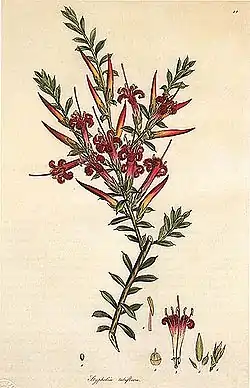| Styphelia tubiflora | |
|---|---|
 | |
| Red five-corner at Ku-ring-gai Chase National Park, Australia | |
| Scientific classification | |
| Kingdom: | Plantae |
| Clade: | Tracheophytes |
| Clade: | Angiosperms |
| Clade: | Eudicots |
| Clade: | Asterids |
| Order: | Ericales |
| Family: | Ericaceae |
| Genus: | Styphelia |
| Species: | S. tubiflora |
| Binomial name | |
| Styphelia tubiflora | |
Styphelia tubiflora, known as red five-corner is a shrub found in eastern Australia. The habitat is poor sandy soils, in dry eucalyptus forest or heathlands. It occurs in areas such as Sydney, Jervis Bay and the Blue Mountains.
It was first described by James Edward Smith in 1795.[1][2]
Description

Typically it grows around 50 centimetres (20 in) tall. The leaves are small, 7 to 24 millimetres (0.28 to 0.94 in) long, 1.5 to 3.3 millimetres (0.059 to 0.130 in) wide.[3] Oblong or obovate in shape, with a sharp tip and very short leaf stem. Flowering occurs between April and August. Attractive red flowers 25 millimetres (0.98 in) long and more or less tubular in shape. Occasionally the flowers are yellowish green or cream. The fruit is small and globular, containing five seeds.
References
- ↑ "Styphelia tubiflora". Australian Plant Name Index, IBIS database. Centre for Plant Biodiversity Research, Australian Government. Retrieved 2021-06-04.
- 1 2 Smith, J.E (1795). "A Specimen of the Botany of New Holland". 1 (4): 45, t. 14.
{{cite journal}}: Cite journal requires|journal=(help) - ↑ "Styphelia tubiflora Sm". PlantNet. Retrieved 10 February 2018.